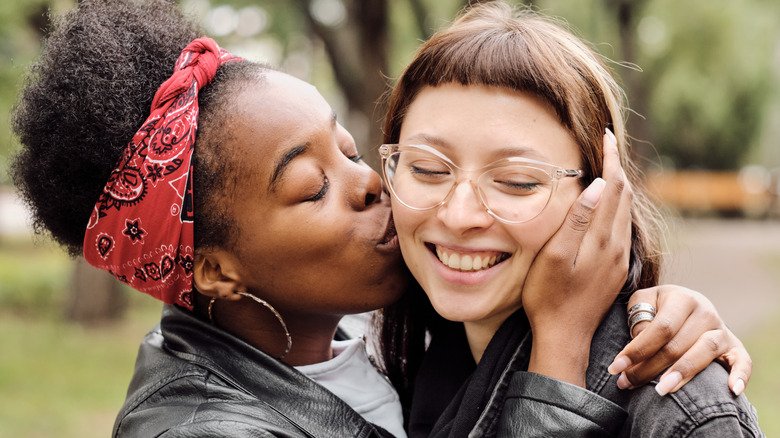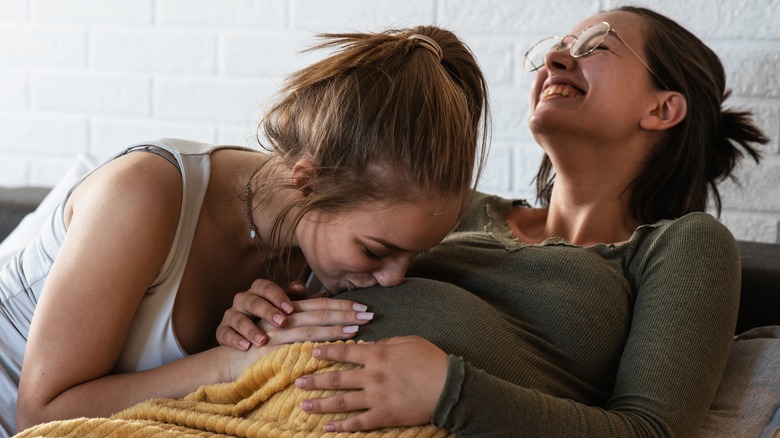Your Guide To Finding Out What Your Relationship Attachment Style Is
After almost 20 years of research throughout the 1950s, 60s, and 70s — mainly by psychologists John Bowlby and Mary Ainsworth — the attachment theory was developed. In a series of studies, Bowlby and Ainsworth examined how children's security was affected by their attachment to their mother (or primary caregiver) and, if those children were deprived of their mother's attention, how it played a role in their interactions with others.
"The theory states that the primary goal of a human infant is to maintain proximity to its caregiver, [which] was necessary for survival during our evolution," psychologist and couples therapist Krista Jordan, Ph.D., tells PsychCentral. "Bowlby believed that because of this evolution, infants and toddlers were monitoring their parents to see what strategies would allow them to stay close."
Over time, the research deduced that attachment styles could be broken up into four categories: secure, anxious, avoidant, and anxious-avoidant. What Bowlby and Ainsworth found in their studies is that the attachment styles we have as children are something we carry with us into adulthood, impacting the relationships we have as adults. "We unconsciously expect our romantic partners to act as our parents did, and therefore, we act in certain ways due to these expectations," says Jordan. Knowing our attachment style isn't useless information: it's another piece of the pie in understanding our behavior in our relationships with others. It can be a major asset in maintaining healthy connections with those around us.
Secure attachment style
Although no attachment style is necessarily better than another, those with a secure attachment style do have an easier time communicating, sharing their emotions, and overall relating to people. As the name suggests, these people feel secure in the relationships they have with others. Those with a secure attachment style basically have open hearts in that intimacy and trust come easy to them, something that's directly the result of their primary caregivers being 100% present from childhood into adulthood, via The Attachment Project.
"Relationships for securely attached adults will still have ups and downs," psychotherapist Holly Roberts tells Cosmopolitan, "but you'll be more able to withstand any difficulties that might arise. You'll be more able to regulate your emotions, meaning it's a bit easier to handle sadness and upset in a more balanced way."
According to a 2015 study published in Psychiatry Research, the majority of U.S. adults, at 63.5%, have a secure attachment style. For the most part, these people are likely to have long-lasting and fulfilling relationships because their ability to love isn't compromised by a childhood that left them feeling deprived or unseen. People with a secure attachment style are more likely than other attachment styles to resolve conflict in a healthy, productive way.
Anxious attachment style
On the opposite end of the spectrum from the secure attachment style are insecure attachment styles, which are anxious, avoidant, and anxious-avoidant. People with an anxious attachment style aren't simply just anxious, but fearful. Even if they're standing on solid ground, they may be waiting for the bottom to fall out or to be betrayed by those close to them. In fact, they're so preoccupied with abandonment that this attachment style is also called preoccupied attachment disorder.
"The theory goes that an anxious attachment style develops when, in your early interactions with others, these others are unpredictable or inconsistently responsive," psychologist Pascal Vrticka tells Vice. As Vrticka explains, this could look like being distressed as a child and sometimes being comforted, while other times being ignored or rejected. Because the child never knows what to expect, they grow up unable to trust and always unsure of themselves and their surroundings.
In a relationship, this could result in jealousy and obsessive neediness. "You long for the comforting kind of interaction that you sometimes get — because it makes you feel good, and it's, of course, exactly what our attachment system is made for, to get supported by somebody, to have somebody around us to whom we feel socially connected and who can help us co-regulate our emotions," says Vrticka. Someone with an anxious attachment style may struggle to make connections, romantic and otherwise, because they don't have the foundation that supports the type of openness that is required. The fear of rejection is something that just can't be shaken.
Avoidant attachment style
What's interesting about the avoidant attachment style is that these people initially come off as secure and independent — until you dig a little deeper and realize it's a coping mechanism. As children, they were forced to handle things on their own, so as adults they follow the same emotional path and struggle to let others into their lives.
"Commonly, people with avoidant attachment don't prioritize partnership in their life," sex therapist Carolina Pataky, Ph.D., tells Women's Health. "They are individuals who retract, hide, and refuse to communicate their emotions, and who often feel uncomfortable when someone else seeks out emotional, physical, or other forms of intimacy."
According to Pataky, this attachment style stems from an unstable childhood, one that may have included divorce, the death of a caregiver, or any situation that would have resulted in a lot of moving from one place to another. "In many cases these kids have to learn to deny the importance of their feelings," says Pataky. It's not that these people want to be emotionally unavailable, but their childhood has conditioned them to be so. Unlike anxious attachment styles, the need for love, intimacy, and feeling valued is buried, because as a child it was suppressed by those who were supposed to offer these things. It's all a textbook definition of fear of commitment.
Anxious-avoidant attachment style
Those with the anxious-avoidant attachment get a double-whammy: it's a combination of both the anxious and avoidant styles. Also known as fearful-avoidant and disorganized attachment, those with this type of attachment style want intimate connections (the anxious part), but don't know how or aren't equipped to have those connections (the avoidant part). It's an inner struggle to be part of something that many can experience (love and intimacy), against the need, due to their childhood, to protect themselves from emotional and mental harm. In a lot of cases, this attachment style is the result of some sort of emotional trauma, per Psychology Today.
"It is displayed in adults through poor coping skills, a lack of coping strategies, erratic behavior, and difficulty dealing with issues in relationships and in real-life problems," therapist Chamin Ajjan tells Mind Body Green. "Those with disorganized attachment can be unpredictable and volatile in relationships."
According to research, there's a link between disorganized attachment style and Borderline Personality Disorder (BDP), with BDP being more common in those with this attachment style. A 2019 study published in Personality Disorders also found that mothers with BPD are more likely to have children with a disorganized attachment style. But it should be noted that this is the rarest type and that only 5% of the population has it, per Thrive.
Why it's important to know your attachment style
When we know why we do things, we're more able to make sense of the world around us and navigate the relationships we have with people. If you've spent the majority of your adult life struggling to make connections or not allowing yourself to be vulnerable, but you don't know why, then knowing your attachment style could help.
"While you can't fully change your attachment style, you can work to understand your attachment style, how it affects your behavior and thinking in your relationships, and build skills to counteract the negative effects of insecure attachment," licensed psychologist Jessica January Behr tells Insider. It's like being given a map of a race, so you already know how you'll handle the speed bumps and potholes along the way. It can make you more confident and secure in your relationships, even if your attachment style falls under the insecure umbrella. You'll be aware of your instinctual behavior and responses, so you can jump in front of it and try to curb your reactions.
As Behr points out, you can't really change your attachment style (although therapy can really help), so you might as well understand it. Because attachment styles are conceived in childhood, they really are the groundwork on which relationships are built. Everything a healthy relationship needs — communication, trust, openness, honesty, conflict resolution skills, and more — is determined by our attachment style. Knowing that one fact about ourselves can really make a big difference in the relationships we have now and will have in the future.





